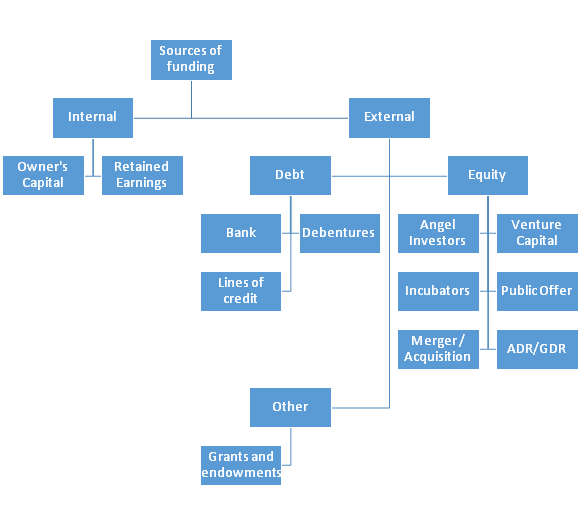This article is written by Shome Bhattacharjee
Cash is the lifeblood of any business, whether it’s as high tech as an online retailer, or as seemingly mundane as running a grocery store. Without cash, a business dies; it’s as simple as that. The different sources all have their own pros and cons and are suitable for different stages at a start-up’s life cycle. To make sense of it all, we need to explore the fund flow cycle chronologically.
So here is a brief and basic overview of some of the more popular sources of funding today in India. The following article is the first instalment of a series that explores the options available to a start-up through the different stages of its life, from product conceptualization and design (where the founder invests her own money as well as that from family and friends) all the way to an IPO (where funds are acquired from the public and institutional investors). The funding options, in terms of their applicability differ from industry to industry. For our purposes, we will take the life cycle of a typical tech startup.
The following flow charts show the basic classification of sources of funds for a startup.
The above chart shows some of the funding sources available to startups in India. We will go through all of them chronologically
Stage 1 –Seed
This is the part of an entrepreneur’s path where she has a viable business idea. The viability of the idea may be evaluated through market research to see if the product or service has potential to work and if the same can be scaled up. The main emphasis at this stage is to give shape to the idea and develop a working prototype to show potential investors that the idea works.
Let’s take an example:
Suppose you decide that you want to build an online real estate agent business. Assuming you want to build a business similar to that of real estate brokers, as opposed to sites like 99acres.com, (I.e. provide a differentiated data, as opposed to an online advertising site), the first thing you need to do is build a database. Whether you go about it personally or hire someone else, whether you actually visit locations or use telephones and the internet, either way, you will have to spend some money. Even if you have registered your domain name and set up your website, you cannot depend on it to generate any cash yet, whether by way of commission on rent/sales or by way of advertisement (due to a lack of traffic). So, even as your business is not giving you any ready cash, you still need money in order to build it. There are always going to be some fixed costs that must be paid for. Thus, every day, you will need to spend a certain amount of money. The rate at which this money is spent is called burn rate. As you can see below, assuming that the burn rate remains constant, you will eventually run out of cash reserves.
Here, as we have just seen, there is no revenue since the product has not been commercialized yet and thus the company cannot generate its own funds. The primary source of funding is the entrepreneur’s personal wealth. If required, additional capital may be acquired from:
1.1 Borrowed funds
· FFF
The 3Fs, i.e., Friends, Family, and Fools (FFF in the above diagram). Friends and family do not invest in the product or the company as much as in the entrepreneurs. They put their money in the hands of the entrepreneur, not necessarily because they believe in her idea, but because they either believe in her, or feel obligated to help her.
· Bank loans
In addition to the FFF, the entrepreneur may secure loans from a bank, mostly as a personal loan, as opposed to a business loan since neither the product, nor the business plan is ready. Thus, as far as bank debt is concerned, the entrepreneur may choose to post her own assets, such as her house or car, as collateral, or opt for a personal loan, at a higher interest.
1.2 Selling a stake
Apart from the previously mentioned sources of borrowed funds, an entrepreneur may also opt for funding by offering a small stake of the business to outside investors. The most critical question here is, “do I want the whole of a small cake, or do I want a part, albeit a large one, of a larger cake.”
There are two noteworthy options here:
-
Incubators
Incubators may be online or in a physical space. Incubators look for between 5-8% stake in a company and offer a small(er) sum of money compared to other sources. These help make a prototype, and further make a product out of the idea. Incubators offer entrepreneurs multiple things that are needed to start a business, for e.g., an office space, the services of professionals, such as lawyers or accountants, or even a room to hold meetings. Over and above these resources, which are shared by all the incubators, a startup will also have access to two very important things, networks and mentoring.
(Incubators may also provide infrastructural support to startups by charging a monthly rent instead of getting a stake in the company. While this varies from case to case, it may be worthwhile for an entrepreneur to consider such an arrangement.)
-
Angel investors
Angel investors are affluent or high net worth individuals who assist the next generation of startups. They are motivated, not only due to the financial returns they get, but also by providing valuable guidance to the startup. Angel investors look for returns between 20-30 times their initial investments. As a rule, Angels invest in businesses that they have experience in and thus a company would do well to take advantage of their experience. They understand the technology involved and invest in the intrinsic value of a firm’s idea, as opposed to making decisions based primarily on financial reports and statistics. Angels may invest as individuals, or collectively as Angel Funds (though it has become difficult to do so, thanks to the AIF Rules, 2012). Angels may look for board positions and may look to exit before IPOs or Acquisitions by selling their stake to Venture Capital funds. One important fact to consider is that the investors can help a company to secure VC funding since they have personal contacts, thus strategically, having an angel investor on board may make a lot of sense for the company to reach its objective.
Conclusion
Have you ever been to a restaurant and thought that you could probably make much better food than what you just ate? Maybe you can, maybe you can’t, but to actually turn that into a business requires a lot more knowledge and knowhow than just the recipe for the best biryani in the world.
This article was not written for a professional with a background in finance, it was written as a starting point for someone who has not had an education in finance, someone who passionately believes in her idea, but does not know how to start. Even if you have great technical skills and are one of the best at what you do, you probably need to acquire a few more skills, at least a working knowledge of certain things. Hopefully this article will serve as a first step in that direction.














